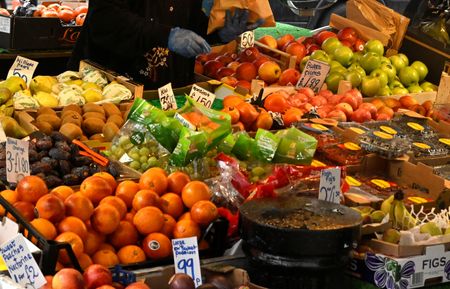By Andy Bruce and William Schomberg
LONDON (Reuters) -Britain’s stubbornly high inflation rate fell by less than expected last month and a closely watched measure of core price rises surged to a 31-year high, according to official data that raised the chances of more interest rate hikes.
Consumer prices rose by 8.7% in annual terms in April, down from 10.1% in March but still leaving Britain with the joint highest rate of inflation among Group of Seven advanced economies alongside Italy.
In Western Europe, only Austria had a higher rate.
Economists polled by Reuters had forecast that the headline CPI annual rate would drop to 8.2% in April, moving further away from October’s 41-year high of 11.1%.
Earlier this month, the Bank of England (BoE) forecast inflation of 8.4% for April.
British government bond prices plunged as investors piled on bets that the BoE will be forced to raise interest rates repeatedly until the end of the year.
“With inflation proving stickier than the Bank expected, it now seems all but certain that the Bank will raise interest rates from 4.50% to 4.75% in June and perhaps a bit further in the months after,” Paul Dales, chief UK economist at Capital Economics, said.
Governor Andrew Bailey and other top BoE officials have come under increasing criticism for the surge in inflation. One lawmaker accused central banks of a “woeful neglect of duty” on Tuesday during a hearing in parliament.
High inflation is a problem for Britain’s government as well as the BoE. Prime Minister Rishi Sunak promised at the start of 2023 to halve inflation, which would require it to fall to around 5% by the end of the year.
Sunak made the promise as one of his priorities for 2023 before an expected national election next year, with his Conservative Party flagging in opinion polls.
The BoE is due to announce its next decision on rates on June 22 and after Wednesday’s data investors were pricing the likelihood of another quarter-percentage point increase in borrowing costs next month at 100%, up from 83% on Tuesday.
Sterling rose against the U.S. dollar and the euro after the figures were published before giving up some of those gains.
Two measures of underling price growth that are closely watched by the BoE – core inflation, which excludes energy, food and tobacco prices, and price increases in the services sector – both hit their highest rates since March 1992.
The economists polled by Reuters had largely expected the core inflation rate to be unchanged.
Despite the most recent fall, inflation continued to eat into the spending power of workers whose pay is rising by less.
The BoE is worried that the surge in inflation might lead to a lasting upward shift in wage demands and businesses’ pricing strategies, exacerbated by a post-pandemic cut in Britain’s labour force and problems caused by Brexit.
Annual food and drink price inflation – which soared to its highest rate since 1977 in March – cooled only marginally in April to 19.1% from 19.2%.
“Although it is positive that it (inflation) is now in single digits, food prices are still rising too fast,” finance minister Jeremy Hunt said in a statement. “We must stick resolutely to the plan to get inflation down.”
The ONS data offered some signs that price rises for goods will slow, potentially helping soften some of the pain for consumers paying more for services.
Prices paid by factories rose by the least in more than two years, up 3.9% compared with April 2022. The prices they charged increased by 5.4%, the smallest increase since July 2021.
(Reporting by Andy BruceEditing by William Schomberg, William James, Elaine Hardcastle)





